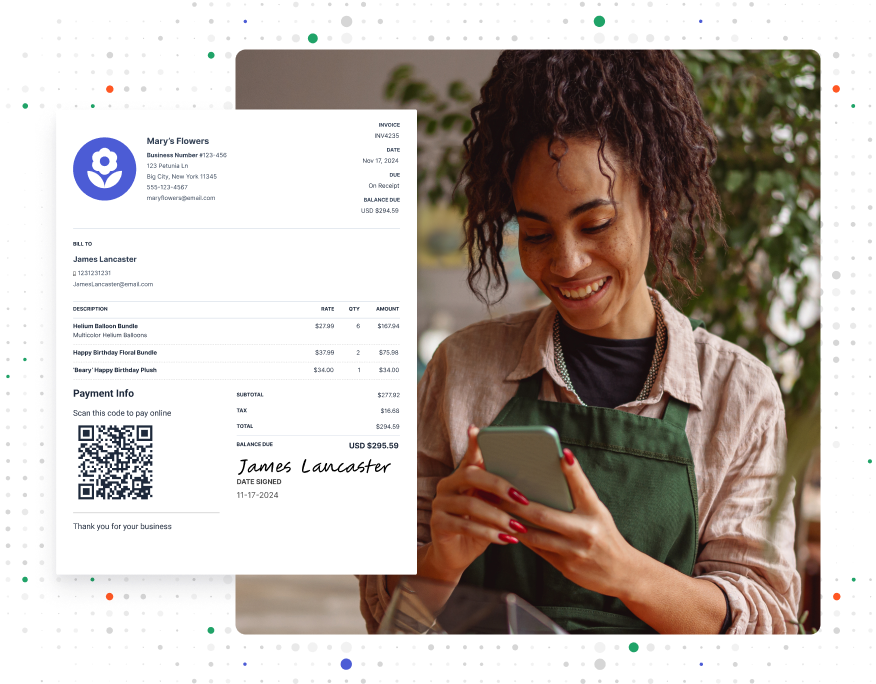Communication Methods Within a Business and How To Improve Your Skills

Effective communication is at the heart of any business. It helps staff build relationships with customers and peers. But communication is more than “Hello” and “Goodbye.” It takes skill, and it impacts everything from problem-solving to customer loyalty. Practicing different communication methods boosts your skills—leading to better business all around.
Here are the five main communication methods you need to know.
What Is Communication?
Communication is a fundamental human skill that lets people understand each other and work together. So it’s no surprise that communication is important to the business world. Clear and concise interactions keep things running smoothly, whether you’re a small business owner or a freelancer.
5 Main Types of Communication

Business communication falls into five broad categories, each with pros and cons.
Here’s a guide to different communication methods and how they lead to success:
- Oral communication is any form of spoken communication. This could be in person or in virtual meetings. It allows for feedback and clarification right away, so it’s best for meetings and group discussions.
- Written communication is any message that is written or typed. This could be emails, statements of work, and invoices, and they provide a record of interactions.
- Visual communication relies on images, charts, and other visual aids. It makes information easier to grasp, especially for visual learners.
- Non-verbal communication is without words. It includes facial expressions, tone of voice, and body language. These can change the meaning of a statement.
- Contextual communication is about the relationship between you and your audience. It includes any outside factors impacting the conversation, like previous successful collaborations. They can influence the meaning of your words and how others receive them.
RELATED LINK — How To Send an Invoice
Communication Methods in the Workplace
Let’s look at the main forms of communication. Methods of communication in the workplace include:
- Face-To-Face. In-person interactions use non-verbal cues and oral communication to share feelings and ideas. Examples are conversations and presentations.
- Email. Email allows time for thoughtful writing and can reach many people at once. This makes it ideal for sharing long-form updates. It’s a good choice for documenting decisions or important conversations.
- Phone and Video. Voice calls provide more insight into people’s tone and feelings. Video calls add a visual element with screen sharing and live collaboration, which makes them better for longer meetings and debriefs.
- Instant Messaging. A lot of business happens online. And instant messaging is one of the most common workplace communication methods. Platforms like Slack are perfect for quick questions and updates. They work well for both individuals and groups.
- Collaboration Platforms. These tools provide a central place for discussions. They’re also useful for file sharing and task updates. This makes it easier for everyone to stay on the same page. Some popular collaboration platforms are Asana, Trello, and Jira.
RELATED LINK — When Should You Use Progress Invoicing?
5 Ways To Improve Your Communication Skills

With a solid understanding of the types of communication in business, learn how to use them. Use these strategies to take your communication skills to the next level:
1. Engage Your Audience
An active conversation is better than a one-sided lecture. If you’re pitching an idea, ask people to take part. They can give input and ask questions, which helps them comprehend and remember what you’re saying.
2. Practice Active Listening
Pay close attention when others are speaking. Avoid interrupting, and ask questions to make sure you see their point of view. This shows the speaker you care about what they’re saying. It also reduces misinterpretations.
3. Maintain Eye Contact
In face-to-face interactions, maintain eye contact. This builds trust and connection. It also helps you see if someone follows or looks confused.
4. Interpret Non-Verbal Cues
Pay attention to faces, body language, and tone. These give insight into how people receive your words.
5. Choose the Right Channel
Choose the best way to communicate based on your message. Also consider what the people you’re talking to would prefer. For example, don’t deliver sensitive feedback in an instant message. This can come across as impersonal and may fail to convey nuances. A meeting is a better choice.
RELATED LINK — How To Offer Net 30 Terms (for Small Businesses & Contractors)
4 Extra Tips for Strengthening Your Online Communication Skills
Freelance jobs, investor meetings, and collaborations can all happen online. So no matter who you are, mastering online communication is a must. The tips above apply to any business interaction. But the following are especially helpful in getting your point across online:
1. Respond Promptly
To maintain a steady flow of information, make a point to respond to messages and emails fast. Even a brief reply to let the sender know you’ve received their message is enough if you can’t provide a more thorough answer right away. It shows people that you respect their time.
2. Enforce a Time Limit
In virtual meetings, distractions and technical difficulties can derail discussions. The lack of visual cues can also hinder the flow of conversation. This makes meetings run longer than needed.
To keep meetings focused and productive, establish and adhere to a set time limit. This encourages concise, efficient communication. Follow up on other channels for less urgent or more in-depth discussions.
3. Follow Virtual Meeting Etiquette
Establish basic rules of etiquette for virtual meetings, which helps them run smoothly and professionally. This includes staying present and muting yourself. It could also include keeping your camera on.
4. Recap Important Details
To make sure your audience grasps your ideas, summarize the main points. Do this for meetings or at the end of long emails. It helps reinforce understanding and provides a reference for later.
The 5 Cs of Effective Communication for Business

Communication experts praise the 5 Cs. These are clarity, conciseness, concreteness, completeness, and courtesy.
Many of the tips above include these traits. But remembering the 5 Cs is one of the best ways to boost your communication skills fast:
1. Clarity
Clear communication is important. It makes sure your audience grasps what you’re saying.
Use simple language. Break down complex ideas into key points. This avoids confusion and misinterpretation.
2. Conciseness
Being concise shows respect for others’ time and helps you hold their attention. Get to the point quickly. Focus on delivering your message without unnecessary details or digressions.
3. Concreteness
Concrete messages are more memorable and persuasive. Use specific examples, data, and facts to illustrate your points. This makes them easier for others to grasp.
4. Completeness
Include all necessary context. This will help your audience understand and take action. Leaving out critical details could lead to confusion.
5. Courtesy
Courtesy is respect. It encourages positive relationships and creates a more pleasant environment, whether you’re working with customers or coworkers. Be professional and kind every day. This builds trust and promotes open communication because people feel more at ease.
Stay on Brand and Look Professional With Invoice Simple
Invoice Simple helps you communicate better. Use branded templates to stand out to clients and show professionalism every time.
Start Your First
Invoice Today
Create customized and professional
invoices and connect with clients
